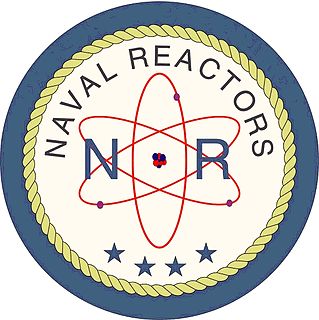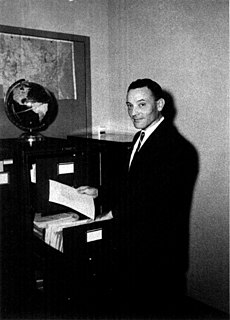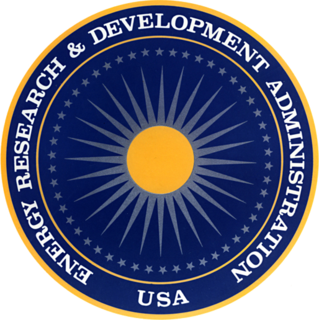
Stephen O. Dean (born May 12, 1936) is an American physicist, engineer and author. He was born in Niagara Falls, New York, United States, and grew up there through high school.

Stephen O. Dean (born May 12, 1936) is an American physicist, engineer and author. He was born in Niagara Falls, New York, United States, and grew up there through high school.
Dean received his BS in physics from Boston College in 1960 and an SM in nuclear engineering from MIT in 1962. He completed his doctorate in physics from the University of Maryland (1971).
Dean has worked for over 50 years as a scientist and manager on the development of fusion for energy and other applications. After receiving his nuclear engineering degree from MIT in 1962, he joined the U.S. Atomic Energy Commission (AEC) as a staff physicist in the Controlled Thermonuclear Research (CTR) branch of the Research Division. The CTR branch was responsible for management of the U.S. fusion energy research program. [1] In 1966, Dean co-authored the AEC’s Policy and Action Paper on Controlled Thermonuclear Research [2] [3] which, after reviews by the AEC’s General Advisory Committee, the Office of Management and Budget, and the President’s Science Advisory Committee, was sent to the Congressional Joint Committee on Atomic Energy by the AEC. [4]
In 1969, Dean transferred to the U.S. Naval Research Laboratory (NRL) as an experimental physicist where, over the next three years, he performed experiments on laser-produced plasmas, published three scientific papers [5] and completed his Ph.D. in physics at the University of Maryland. [6] In February 1972, he received the Naval Research Laboratory Research Publication Award. [7]
In early 1972, he returned to AEC and became an Assistant Director of the newly-formed CTR Division. [8] In 1973, he chaired a review panel on the Status and Objectives of Tokamak Systems for Fusion Research. [9] In 1975, the AEC became the US Energy Research and Development Administration (ERDA). He became the Director of the (magnetic) Confinement Systems Division, within the newly-established Office of Fusion Energy (OFE) where he led the preparation of the Fusion Power by Magnetic Confinement Program Plan. [10] In 1977, ERDA became the US Department of Energy (DOE). In August 1979, Dean left government and co-founded (with Nicholas Krall and Alvin Trivelpiece) Fusion Power Associates, a non-profit scientific research and educational foundation and serves as the association’s president. [11]
In 1981, Dean edited the book Prospects for Fusion Power. [12] In 1982, he contributed to the book Nuclear Power: Both Sides, [13] edited by Michio Kaku and Jennifer Trainer. During 1985-1987, he co-led the DOE-commissioned Technical Planning Activity. [14] For that work, in March 1988, he received a DOE Distinguished Associate Award from DOE Secretary of Energy John S. Herrington. [15] In 1987 he was elected Fellow of the American Nuclear Society (ANS). [16]
Dean served as a member of the DOE Fusion Energy Advisory Committee (FEAC) 1991-1994. In 1992, he led a FEAC study on Concept Improvement. [17] In 1995, he served on the Secretary of Energy Advisory Board Task Force on Strategic Energy Research and Development. [18] In 2002, he authored an article “Fifty Years of Fusion Research” in the American Nuclear Society magazine Nuclear News. [19] In 2003, he served on a subpanel of the DOE Fusion Energy Sciences Advisory Committee (FESAC) to prepare a new fusion program plan. [20] In 2011, he authored Chapter 31, “Historical Origins and Development of Fusion Research” in the Nuclear Energy Encyclopedia. [21] In 2013, he published his book Search for the Ultimate Energy Source – A History of the U.S. Fusion Energy Program. [22] In January 2017 he did an interview with journalist Miles O’Brien, a portion of which aired on the PBS NewsHour. [23] In September 2017 he did a podcast interview for Episode 20 of the Energy-Cast series. [24]
In 2018, he received the Albert Nelson Marquis Lifetime Achievement Award. Marquis Who's Who states that recipients are chosen on the basis of "noteworthy accomplishments, visibility, and prominence" in their chosen fields. [25]

A tokamak is a device which uses a powerful magnetic field to confine plasma in the shape of a torus. The tokamak is one of several types of magnetic confinement devices being developed to produce controlled thermonuclear fusion power. As of 2016, it was the leading candidate for a practical fusion reactor.

Princeton Plasma Physics Laboratory (PPPL) is a United States Department of Energy national laboratory for plasma physics and nuclear fusion science. Its primary mission is research into and development of fusion as an energy source. It is known in particular for the development of the stellarator and tokamak designs, along with numerous fundamental advances in plasma physics and the exploration of many other plasma confinement concepts.

The United States Atomic Energy Commission, commonly known as the AEC, was an agency of the United States government established after World War II by U.S. Congress to foster and control the peacetime development of atomic science and technology. President Harry S. Truman signed the McMahon/Atomic Energy Act on August 1, 1946, transferring the control of atomic energy from military to civilian hands, effective on January 1, 1947. This shift gave the members of the AEC complete control of the plants, laboratories, equipment, and personnel assembled during the war to produce the atomic bomb.

The United States Department of Energy (DOE) is a cabinet-level department of the United States government concerned with matters of federal energy policy and the safe handling of nuclear material. The DOE is responsible for the U.S. nuclear weapons program, nuclear reactor production for the United States Navy, energy-related research, and domestic energy production and energy conservation.
This timeline of nuclear fusion is an incomplete chronological summary of significant events in the study and use of nuclear fusion.

The Z Pulsed Power Facility, informally known as the Z machine or Z pinch, is the largest high frequency electromagnetic wave generator in the world and is designed to test materials in conditions of extreme temperature and pressure. It was originally called the PBFA-II and was created in 1995. Since its refurbishment in October 1996 it has been used primarily as an inertial confinement fusion (ICF) research facility. Operated by Sandia National Laboratories in Albuquerque, New Mexico, it gathers data to aid in computer modeling of nuclear weapons and eventual nuclear fusion pulsed power plants.

The Tokamak Fusion Test Reactor (TFTR) was an experimental tokamak built at Princeton Plasma Physics Laboratory (PPPL) circa 1980 and entering service in 1982. TFTR was designed with the explicit goal of reaching scientific breakeven, the point where the heat being released from the fusion reactions in the plasma is equal or greater than the heating being supplied to the plasma by external devices to warm it up.

The Huemul Project was an early 1950s Argentine effort to develop a fusion power device known as the Thermotron. The concept was invented by Austrian scientist Ronald Richter, who claimed to have a design that would produce effectively unlimited power.

Naval Reactors (NR), also known as the Naval Nuclear Propulsion Program, is an umbrella term for the U.S. government office that has comprehensive responsibility for the safe and reliable operation of the United States Navy's nuclear propulsion program. A single entity, it has authority and reporting responsibilities within both the United States Department of the Navy and the United States Department of Energy in its National Nuclear Security Administration.

Project 4.1 was the designation for a medical study and experimentation conducted by the United States of those residents of the Marshall Islands exposed to radioactive fallout from the March 1, 1954 Castle Bravo nuclear test at Bikini Atoll, which had an unexpectedly large yield. Government and mainstream historical sources point to the study being organized on March 6 or March 7, 1954, six days after the Bravo shot.
Robert L. Hirsch is a United States physicist who has been involved in energy issues from the late 1960s. Through the 1970s he directed the US fusion energy program at a variety of government positions as responsibility for the project moved from the Atomic Energy Commission to the Energy Research and Development Administration and finally to the Department of Energy. After that time he was a senior energy program adviser for Science Applications International Corporation and is a Senior Energy Advisor at MISI and a consultant in energy, technology, and management.

Richard Greening Hewlett was an American public historian best known for his work as the Chief Historian of the United States Atomic Energy Commission.

Alcator C-Mod was a tokamak that operated between 1991 and 2016 at the Massachusetts Institute of Technology (MIT) Plasma Science and Fusion Center (PSFC). Notable for its high toroidal magnetic field, Alcator C-Mod holds the world record for volume averaged plasma pressure in a magnetically confined fusion device. Until its shutdown in 2016, it was one of the major fusion research facilities in the United States.
Keeve M. (Kip) Siegel (1923-1975) was an American physicist. He was a professor of Physics at the University of Michigan in Ann Arbor, MI, and the founder of Conductron Corporation, a high tech producer of electronic equipment which was absorbed by McDonnell Douglas Corporation; KMS Industries and KMS Fusion. KMS Fusion was the first and only private sector company to pursue controlled thermonuclear fusion research through use of laser technology.

The United States Energy Research and Development Administration (ERDA) was a United States government organization formed from the split of the Atomic Energy Commission (AEC) in 1975. It assumed the functions of the AEC not assumed by the Nuclear Regulatory Commission.
Alvin Trivelpiece is a retired Director of Oak Ridge National Laboratory (ORNL), former Executor Officer of American Association for the Advancement of Science (AAAS), and former Director of the Office of Energy Research, U.S. Department of Energy (DOE). He has also been a professor of physics and a corporate executive. Throughout his varied career, Dr. Trivelpiece's research focused on plasma physics, controlled thermonuclear research, and particle accelerators. He has several patents on accelerators and microwave devices.
Riccardo Betti is the Robert L. McCrory professor of Mechanical Engineering and Physics and Astronomy at the University of Rochester, in Rochester, NY. Since 2004, he has also acted as the Director of the Fusion Science Center at the Laboratory for Laser Energetics. He received is Ph.D. from the Department of Nuclear Engineering at the Massachusetts Institute of Technology in 1992. Prior to that he studied at the University of Rome (Italy), where he graduated with honors with a degree in Nuclear Engineering in 1987.
KMS Fusion was the first private company to attempt to produce a fusion reactor using the inertial confinement fusion (ICF) approach. The basic concept, developed in 1969 by Keith Brueckner, was to infuse small glass spheres with a fuel gas and then compress the sphere using lasers until they reached the required temperature and pressures. In May 1974 they demonstrated neutron output consistent with small levels of fusion events in a D-T filled target, the first published success for this technique.

The Princeton Large Torus, was an early tokamak built at the Princeton Plasma Physics Laboratory (PPPL). It was one of the first large scale tokamak machines, and among the most powerful in terms of current and magnetic fields. Originally built to demonstrate that larger devices would have better confinement times, it was later modified to perform heating of the plasma fuel, a requirement of any practical fusion power device.
The history of nuclear fusion began early in the 20th century as an inquiry into how stars powered themselves and expanded to incorporate a broad inquiry into the nature of matter and energy, as potential applications expanded to include warfare, energy production and rocket propulsion.